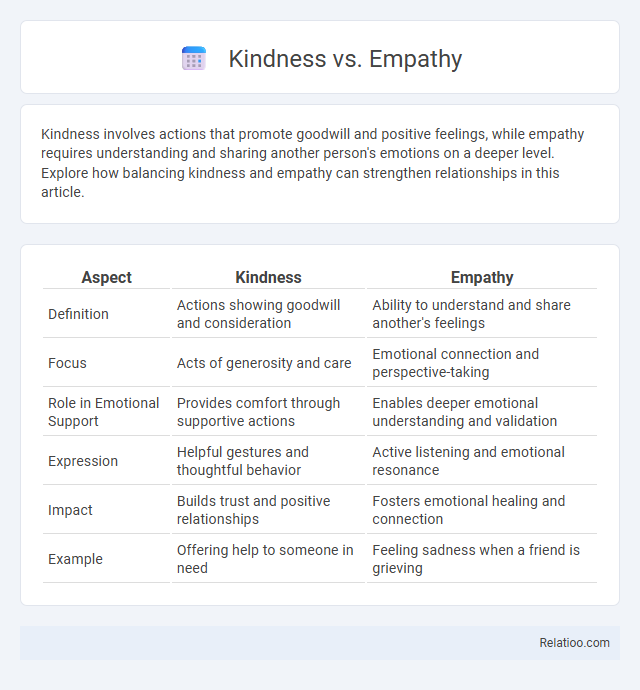Kindness involves actions that promote goodwill and positive feelings, while empathy requires understanding and sharing another person's emotions on a deeper level. Explore how balancing kindness and empathy can strengthen relationships in this article.
Table of Comparison
| Aspect | Kindness | Empathy |
|---|---|---|
| Definition | Actions showing goodwill and consideration | Ability to understand and share another's feelings |
| Focus | Acts of generosity and care | Emotional connection and perspective-taking |
| Role in Emotional Support | Provides comfort through supportive actions | Enables deeper emotional understanding and validation |
| Expression | Helpful gestures and thoughtful behavior | Active listening and emotional resonance |
| Impact | Builds trust and positive relationships | Fosters emotional healing and connection |
| Example | Offering help to someone in need | Feeling sadness when a friend is grieving |
Understanding the Essence of Kindness
Kindness embodies proactive goodwill and compassionate actions toward others, while empathy involves deeply understanding and sharing another person's feelings. Understanding the essence of kindness requires recognizing it as a deliberate choice to act with generosity and consideration, independent of emotional resonance. This distinction highlights kindness as behavioral expression and empathy as emotional insight, both essential for meaningful human connection.
Defining Empathy: Beyond Simple Kind Acts
Empathy goes beyond simple kind acts by deeply understanding and sharing another person's emotions, creating a genuine emotional connection. While kindness involves actions intended to help others, empathy requires you to emotionally resonate with their feelings, fostering stronger and more meaningful relationships. Developing empathy enhances your ability to respond thoughtfully and compassionately to others' experiences.
Key Differences Between Kindness and Empathy
Kindness involves performing generous actions to help others without expecting anything in return, while empathy is the ability to understand and share the feelings of another person. Your acts of kindness can be seen, such as giving time or resources, whereas empathy is more internal, involving emotional connection and awareness. These key differences highlight how kindness is behavior-driven and empathy is feeling-driven, both essential for building meaningful relationships.
The Psychology Behind Kindness and Empathy
The psychology behind kindness and empathy reveals that kindness involves actions driven by altruism and social connection, while empathy is the cognitive and emotional ability to understand and share another's feelings. Your brain activates areas such as the anterior insula and anterior cingulate cortex during empathetic responses, facilitating emotional resonance and compassion. Understanding these mechanisms helps enhance prosocial behavior by cultivating both emotional insight and compassionate actions.
How Kindness Impacts Relationships
Kindness significantly enhances relationships by fostering trust, emotional support, and positive communication. Your consistent acts of kindness create a nurturing environment where empathy flourishes, deepening connections and reducing conflicts. This compassionate behavior promotes mutual understanding and strengthens bonds over time.
The Power of Empathy in Communication
Empathy plays a crucial role in effective communication by allowing you to genuinely understand and share the feelings of others, fostering deeper connections and trust. While kindness involves considerate actions and compassion reflects concern, empathy uniquely bridges emotional gaps through active listening and perspective-taking. Harnessing the power of empathy enhances your ability to respond thoughtfully and resolve conflicts with greater sensitivity.
Everyday Examples of Kindness vs Empathy
Kindness involves actions like holding the door open for someone or offering a smile to brighten a stranger's day, demonstrating simple, tangible gestures of goodwill. Empathy goes deeper by understanding and sharing another person's feelings, such as comforting a friend during a tough time or listening attentively to someone's worries. Everyday examples reveal kindness as outward behavior, while empathy connects emotional insight with compassionate responses that foster meaningful human connection.
Cultivating Kindness and Empathy in Daily Life
Cultivating kindness and empathy in daily life enhances emotional intelligence and fosters deeper human connections by actively listening and responding to others' feelings. Practicing small acts of kindness, such as offering support or expressing gratitude, reinforces a compassionate mindset, while empathy involves understanding and sharing the emotions of others to create meaningful interactions. Integrating mindfulness techniques and reflective exercises helps individuals develop these qualities consistently, promoting a more harmonious and supportive environment.
Overcoming Challenges: When Kindness or Empathy Fall Short
Overcoming challenges often requires more than just kindness or empathy, as these qualities alone may fail to address complex emotional or practical needs effectively. When kindness becomes surface-level or empathy turns into emotional overwhelm, your ability to provide meaningful support is compromised. Developing resilience and combining emotional intelligence with actionable solutions ensures that your efforts lead to lasting positive outcomes in difficult situations.
Building a Kinder, More Empathetic Society
Building a kinder, more empathetic society requires understanding the distinctions between kindness, empathy, and compassion. Kindness involves actions that benefit others, empathy is the ability to feel and understand another's emotions, while compassion combines both by motivating you to alleviate suffering. Your commitment to practicing empathy and kindness fosters deeper connections and creates a more supportive community for all.

Infographic: Kindness vs Empathy
 relatioo.com
relatioo.com